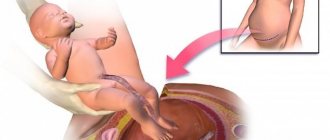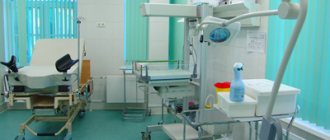Features of pregnancy
It is important for expectant mothers to understand that this pathology is not overly dangerous. Moreover, in some cases, diagnosing TPP does not carry risks for normal childbirth and the health of the baby and the woman in labor. However, statistics show that the anomaly is still associated with an increased risk of complications. That is why, in some cases, surgical intervention is indicated in the management of childbirth.
Possible complications:
- SRD;
- embryo hypoxia;
- early release of water;
- pinching and extension of the fetal head.
To level out complications, it is important to diagnose the anomaly in a timely manner.
Classification
Leg presentation. It is observed in 11-13% of all TPPs.
Divided into the following options:
- complete (both lower limbs);
- incomplete (one lower limb);
- knee
Gluteal. Diagnosed most often.
Divided into two options:
- incomplete (buttocks at the entrance of the birth canal) – 3/4 of cases;
- mixed (both the buttocks and lower limbs are located at the entrance to the pelvis) – 1/4 of the cases.
Depending on the specific type of TPP, the biological mechanism of childbirth has individual characteristics.
Thus, independent childbirth with minimal risks of complications is possible in the presence of an incomplete gluteal TPP, if the embryo is small in size and the mother’s pelvis is normal.
Conversely, the likelihood of asphyxia and prolapse of fetal limbs or the umbilical cord is high when foot or mixed gluteal TPP is diagnosed. In these cases, a caesarean section is recommended.
Causes of TPP
The most common causes of TPP include the following:
- oligohydramnios (the ability of the embryo to take the desired position is limited);
- polyhydramnios (high mobility of the fetus does not allow it to take a normal position);
- umbilical cord entanglement (the activity of the fetus leads to subsequent limitation of mobility due to the umbilical cord that wraps around its body);
- uterine fibroids and other pathologies (affects the position of the embryo);
- multiple births (pregnancy with twins limits the mobility of babies due to lack of free space).
Possible complications:
- childbirth before the due date;
- maternal trauma;
- child injury;
- hypoxia (breech presentation is accompanied by clamping of the umbilical cord).
Breech presentation of the fetus
Breech presentation is a common cause of concern during pregnancy. However, the main thing here is not to start worrying too early. For quite a long time, the baby will have enough space in the uterus for free swimming, somersaults and elegant turns.
Up to 28 weeks of pregnancy, 20–25% of fetuses lie with their butts or legs towards the exit, but only 7–16% remain in this position until 32 weeks of pregnancy. By the time they give birth, most babies turn their heads down, preparing to go out into the big world, and only 3-4% of stubborn ones continue to “sit on their butts straight”1.
Causes of breech presentation
In most cases, breech presentation occurs for no apparent reason, simply as one of the options for the location of the fetus in the uterus. However, in 15% of cases it is possible to find an explanation for this behavior - something prevents the child from taking a different position. This happens with multiple pregnancies, with polyhydramnios or oligohydramnios (too much or too little amniotic fluid), with abnormalities of the uterus (saddle or bicornuate) or uterine fibroids, in cases where the placenta blocks the exit from the uterus.
How to diagnose a “wrong turn”
For the last 100 years, obstetrician-gynecologists have been determining the location of the fetus in the uterus with their hands using Leopold's maneuvers. When a doctor touches a pregnant woman’s belly with his hands at a reception or in a maternity hospital, he is doing exactly that—he is clarifying the location of the fetus in the uterus. The accuracy of external obstetric examination is quite high, but not one hundred percent.
In 1991, an interesting study2 was carried out - an experienced clinician examined 138 women in the gestational age from 30 to 41 weeks, and after that all patients underwent an ultrasound scan. The expert identified three out of eight breech presentations and incorrectly diagnosed breech birth in six cases. It is very easy to make a mistake with maternal obesity, a full bladder, uterine fibroids, polyhydramnios, or the location of the placenta on the anterior wall. A vaginal examination or ultrasound helps to clarify the presenting part.
Often women themselves realize that the baby is “sitting on his butt”: when the fetal head, supporting the diaphragm, interferes with breathing or the baby actively kicks the mother in the lower abdomen.
Attempts to "change direction"
At 36–38 weeks, an attempt can be made to externally rotate the fetus. This method is not easy and has a number of limitations. This procedure is carried out under ultrasound guidance, monitoring the fetal heartbeat and only in an obstetric hospital, where it is possible to quickly stop the rotation in case of sudden problems (placental abruption or rupture of amniotic fluid) and perform a cesarean section.
It is believed that external obstetric rotation is successful in half of the cases, but there are especially tricky fruits that, after a successful rotation, return to their original position. The curious can see how external rotation is performed on the WHO website.
Methods of labor management
Assistance during breech birth has its own characteristics. The first benefit was proposed by the French physician Jacques Guillemeau in 1609. Later, many prominent doctors offered their own options for managing such births. Our country has adopted the manual proposed by Napoleon Arkadyevich Tsovyanov in 1928. The essence of the method is to maintain fetal position until the birth of the head.
The German scientist Erich Bracht in 1936 proposed a similar method of conducting labor, but in combination with pressure on the head through the fundus of the uterus. These methods are still alive, but in our country it is the “Tsovyanov manual”, and in Germany it is the “Bracht method”.
Pregnancy management
Pregnant women who are at risk are subject to medical support, which includes the following measures:
- exclusion of insufficient communication between the mother and child through the placenta;
- prevention of complications for the child;
- leveling disturbances in the functionality of the uterus.
To do this, the list of recommendations includes proper nutrition and proper rest (night and day). This is primarily aimed at eliminating embryo hypertrophy.
In addition, preventive work is aimed at creating a healthy psychological picture in a pregnant woman (stabilization of the nervous state, muscle relaxation techniques, corrective gymnastics). In some cases, antispasmodic drugs are indicated, which are used in special intermittent courses.
Planning of delivery tactics begins at 38-39 weeks of gestation, when the patient is admitted to the hospital. If the condition of the pregnant woman and the embryo is satisfactory (incomplete breech presentation, appropriate size of the pelvis and fetus, physiological readiness of the mother), a decision can be made to give birth naturally. In this case, preventive measures are taken to prevent opening of the membranes, monitoring the condition of the fetus and uterus, preventing fetal hypoxia and labor anomalies. In addition, the list of measures includes epidural anesthesia during childbirth and obstetric support aimed at quickly removing the baby’s head.
Caesarean section is indicated in the following cases:
- aggravated medical history of the pregnant woman (stillbirth, prolonged infertility, miscarriage, Rh conflict, etc.);
- pregnancy with IVF;
- first birth over 30 years of age;
- placena previa;
- large fruit;
- non-standard situation during natural childbirth (emergency surgery);
- presence of a scar on the uterus, etc.
Folk remedies
Photo: instalady.com.ua
Breech presentation is a condition that poses a threat to the life and health of the fetus and mother. Before resorting to alternative treatment, it is worth consulting with an obstetrician-gynecologist. If you follow the prescribed medical recommendations, it is permissible to use alternative methods of preventing breech presentation.
Swimming helps to keep the fetus in cephalic presentation. While in water, a woman’s body is more relaxed, including her uterus. The fetus has the opportunity to maneuver due to the free space that has appeared.
You can help the fetus turn by using gravity. To do this, it is necessary to raise the pelvis relative to the shoulder girdle. The fetus will begin to press its weight on the bottom of the uterus, stretching it: with such stretching of the uterus, more space appears for reversal. This can be done in two ways:
- Lie on your back with your knees and hips bent, place a large pillow under your lower back, and a smaller pillow under your neck. It is recommended to stay in this position for up to 30 minutes a day.
- Stand on your elbows and knees - in this position your pelvis will be higher than your shoulders.
Usually mothers are advised to talk to their baby in the womb, thus trying to persuade the fetus to turn around. Such practices are useless for practicing cephalic presentation, but talking with an unborn child helps create and strengthen the psychological connection between mother and child.
The information is for reference only and is not a guide to action. Do not self-medicate. At the first symptoms of the disease, consult a doctor.
Symptoms
If the fetus is not positioned correctly and there are no other pathologies, pregnancy in most cases proceeds favorably. There are no pathological symptoms. External signs may indicate an abnormal position of the fetus:
- spherical shape of the uterus;
- transversely stretched abdomen;
- the height of the uterine fundus increases slowly and does not correspond to the gestation period;
- abdominal circumference is higher than normal;
- the baby's heartbeat can be heard at the level of the mother's navel;
- The baby's pelvis and head are located on the sides of the abdomen.
Waiting for hour "X"
During a routine examination, the doctor, even without the use of technology, is able to approximately determine the position of the baby in the tummy: head down or butt.
The diagnosis is clarified using ultrasound, simple and three-dimensional echography. Early diagnosis of the type of malpresentation will allow you to develop a corrective program or prepare for natural childbirth with an incorrect position or cesarean section according to indications, which will protect you from many injuries and complications. Until the 32nd-34th week, the baby can be in any position. He has plenty of room for a life-changing acrobatic flip and preparation for birth. Sometimes, causing mommy and doctors to worry, the baby turns over just before the contractions begin, and sometimes even with their onset.
Causes
This anomaly can be caused by various factors that contribute to excessive or, conversely, insufficient activity of the baby in the womb. The main reasons for the anomaly:
- hypotonia of the abdominal muscles;
- oligohydramnios and polyhydramnios;
- fetal hypotrophy;
- tumors of the uterus and pelvic bones;
- increased myometrial tone;
- risk of spontaneous abortion;
- large fruit;
- clinically narrow pelvis;
- multiple births;
- abnormal attachment of the placenta;
- fetal development abnormalities;
- structural defects of the uterus (bicornuate, saddle-shaped).
How can doctors help?
If the condition of the mother and fetus is good, the cervix is mature, and the expected weight of the fetus is small, the birth is carried out under careful control through the vaginal birth canal.
In the first stage of labor (contractions and dilatation of the cervix), the woman must remain in bed to avoid complications (premature rupture of water, prolapse of the fetal leg or umbilical cord loops).
In the second stage of labor , a special so-called obstetric aid is provided (a series of sequential manual techniques to facilitate the birth of a child). The main principle is to preserve the fetal position (the legs are extended along the body and pressed to the chest by the fetal arms). First, the baby is born up to the navel, then up to the lower edge of the angle of the shoulder blades, then the arms and shoulder girdle emerge, and then the head.
As soon as the baby is born up to the navel, its head presses against the umbilical cord; At the same time, hypoxia develops - lack of oxygen. When providing obstetric care, important points are: prevention of premature loss of legs before the birth of the shoulder girdle, assistance, if necessary, in removing the arms and head of the fetus. This is necessary to prevent asphyxia (acute oxygen starvation of the fetus). No more than 5-10 minutes should pass before the baby is fully born, otherwise the consequences of oxygen starvation can be very unfavorable. An incision is also made in the perineum to speed up the birth of the head and make it less traumatic. The incision is made longitudinally towards the anus (perineotomy) and, more often, at an angle (episiotomy). Already during contractions, the woman in labor is always given a drip with saline solution, so that at the moment of pushing there is an opportunity to quickly administer medicine to enhance the contractility of the uterus.
The condition of children born in breech presentation during spontaneous birth requires increased attention. Often, signs of hypoxia suffered during childbirth adversely affect the child’s nervous system. Therefore, all children born in a breech presentation require consultation with a neurologist. Such children often have dysplasia (underdevelopment) of the hip joint. This condition requires timely treatment and diagnosis from the very first days after birth. A neonatologist (children's doctor) must be present at the birth to provide resuscitation measures if necessary. If precautions are taken, children born this way do not differ from their peers.










